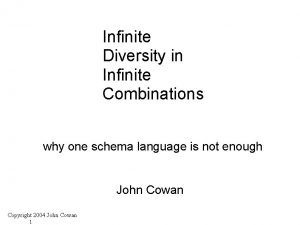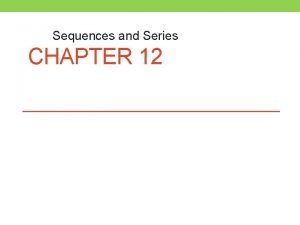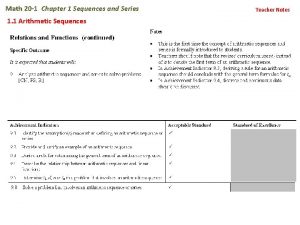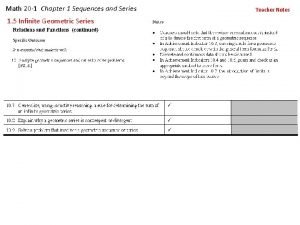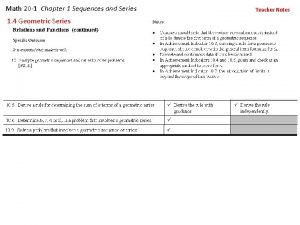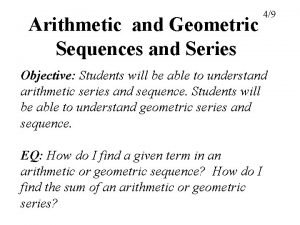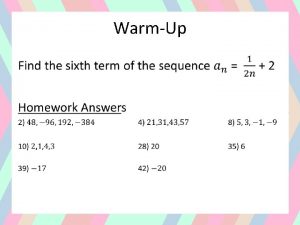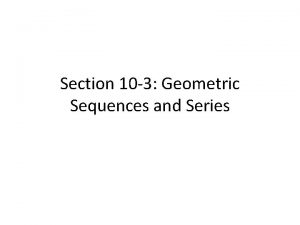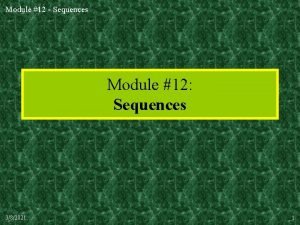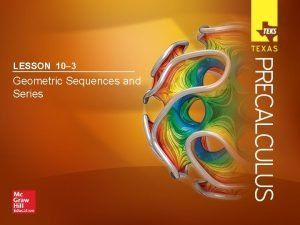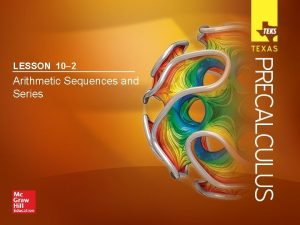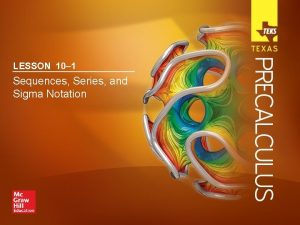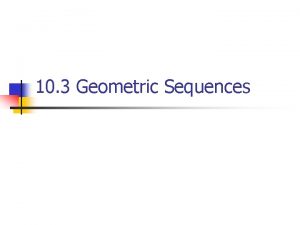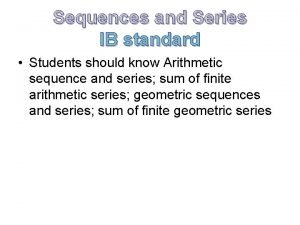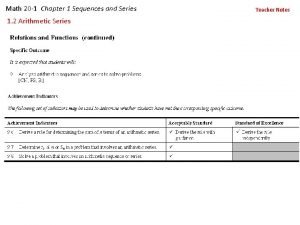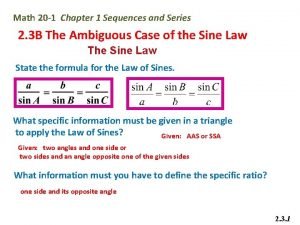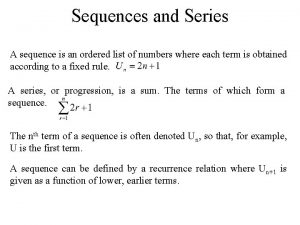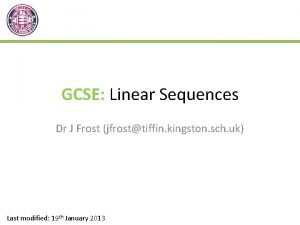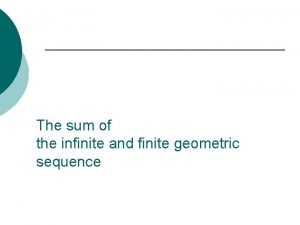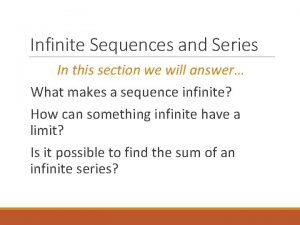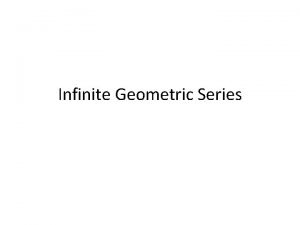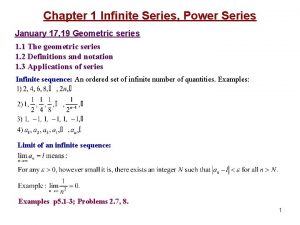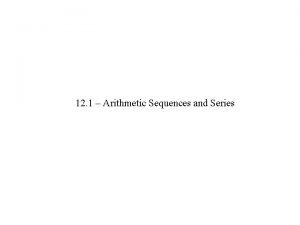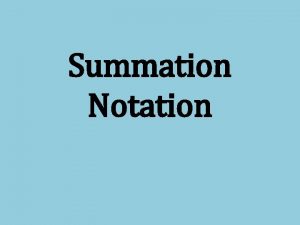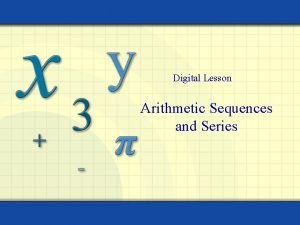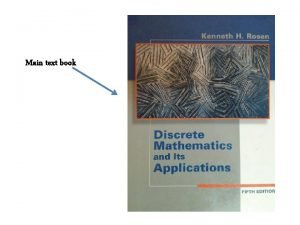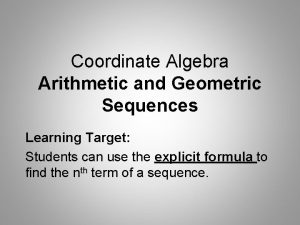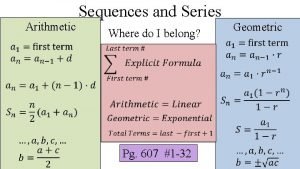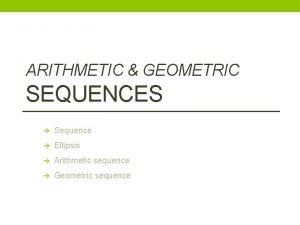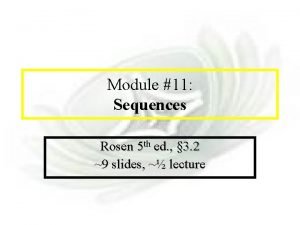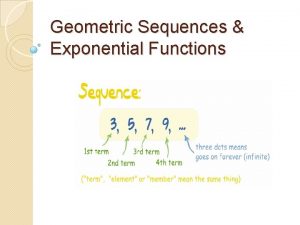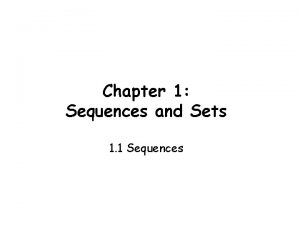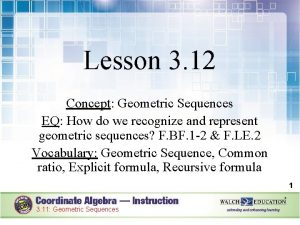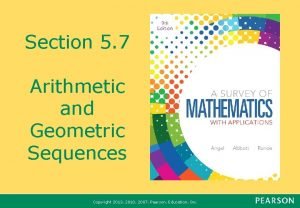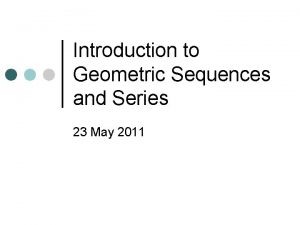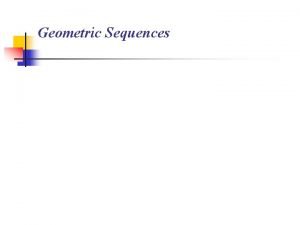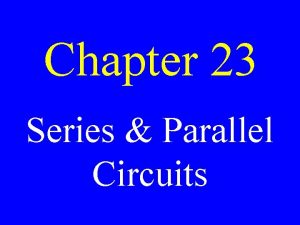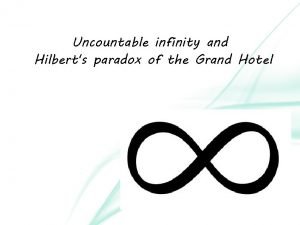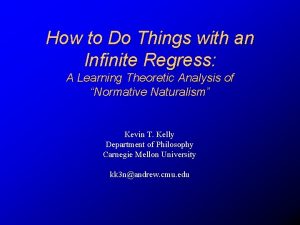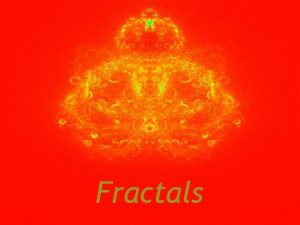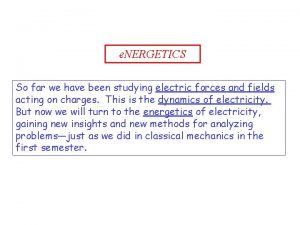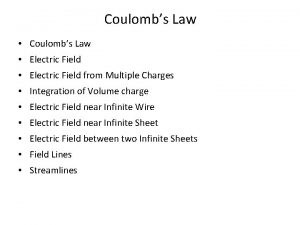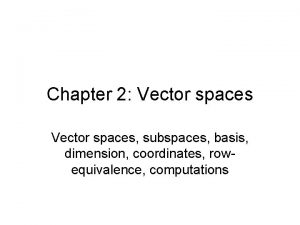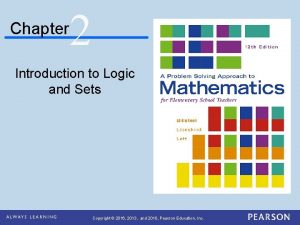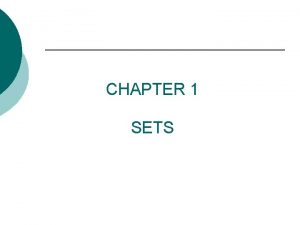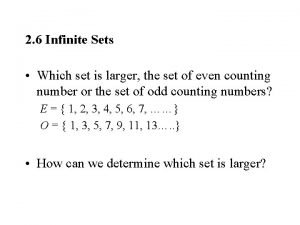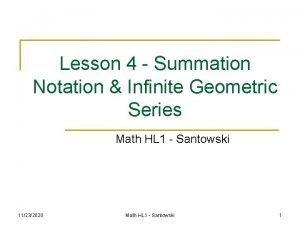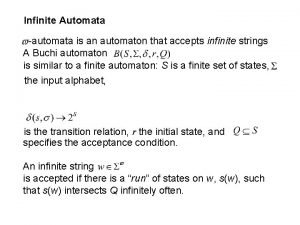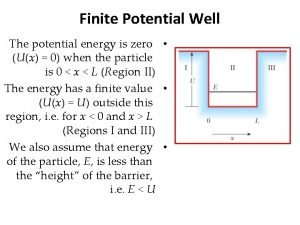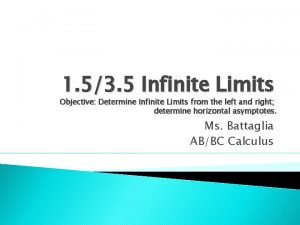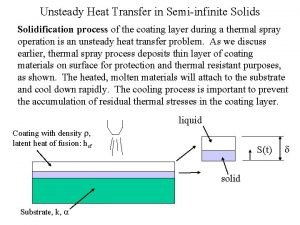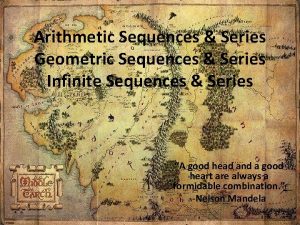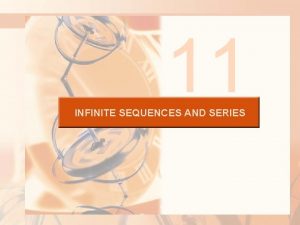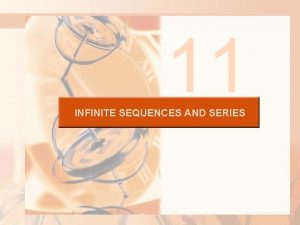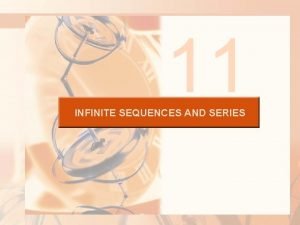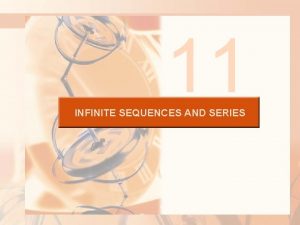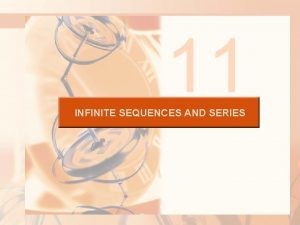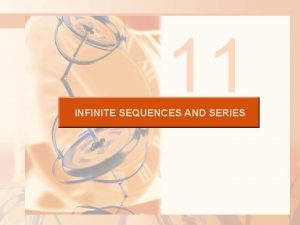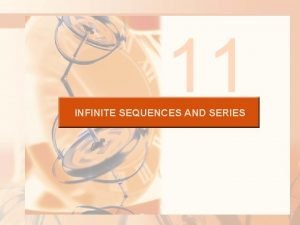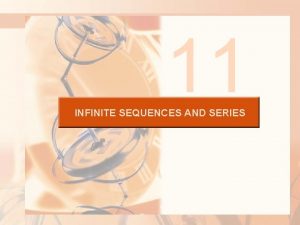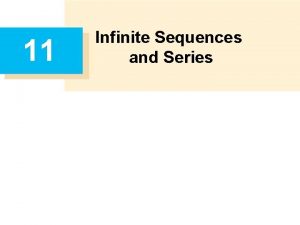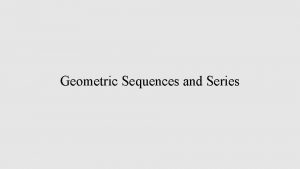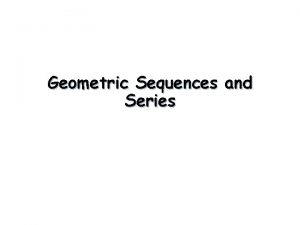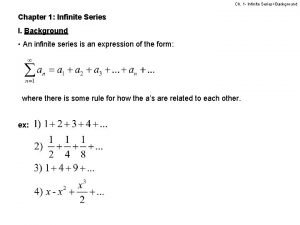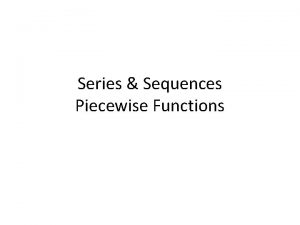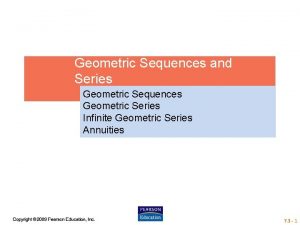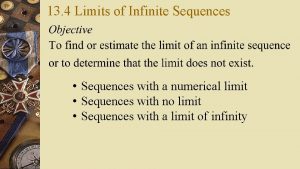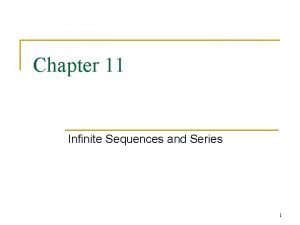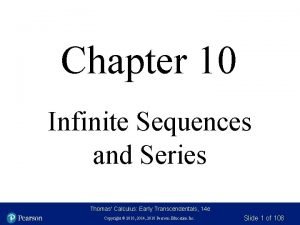Chapter 7 Infinite Sequences and Series 7 1
























































































- Slides: 88

Chapter 7 Infinite Sequences and Series

7. 1 Sequences A sequence is a list of numbers a 1, a 2, a 3, …, an, … in a given order. • Each of a 1, a 2, a 3 and so on represents a number. These are the terms of the sequence. • The integer n is called the index of an, and indicates where an occurs in the list. • Order is important. We can think of sequence a 1, a 2, a 3, …, an…as a function that sends 1 to a 1, 2 to a 2, 3 to a 3, and in general sends the positive integer n to the nth term an. For example, the function associated with the sequence 2, 4, 6, 8, …, 2 n, … sends 1 to a 1=2, 2 to a 2=4, and so on. The general behavior of the sequence is described by the formula an=2 n.

Remarks 1. We can equally well make the domain the integers larger than a given number n 0 (may >1), and we allow the sequence of this type also. 2. Sequences can be described by writing rules that specify their terms, such as or by listing terms, We also sometimes write

Graphically Represent Sequences

Convergence and Divergence Sometimes the numbers in a sequence approach a single value as the index n Increases. For example, an=1/n whose terms approach 0 as n gets large, or an=1 -1/n approach 1 as n gets large. On the other hand, some sequences like an=(-1)n+1 n bounce back and forth Between 1 and -1, never converging to a single value.

This definition is very similar to the Definition of the limit of a function f(x) as x tends to

Examples Example: any constant k. Example:

Diverges to Infinity The sequence { } also diverges, because The sequence { 1, 02, 3, -4, 5, -6, 7, -8, …} and {1, 0, 2, 0, 3, 0, …} are examples of such divergence.

Calculating Limits of Sequences Since sequences are functions with domain restricted to the positive integers, we have

Remark • Theorem 1 does not say that, for example, that if the sum {an+ bn} has a limit, then each of the sequences {an} and {bn} have limits. • One consequence of Theorem 1 is that every nonzero multiple of a divergent sequence {an} diverges.

Examples

Sandwich Theorem for Sequences An immediate consequence of Theorem 2 is that , if |bn| cn and cn 0, then bn 0 because –cn bn cn, we use this fact in the next example.

Examples

Continuous Function Theorem for Sequences Example: Show that

Example • Example: Show that

Using L’Hopital’s Rule

Commonly Occuring Limits


Examples

Recursive Definitions So far, we have calculated each an directly from the value of n. But sequences are often defined recursively by giving 1. The values (s) of the initial term or terms, and 2. A rule, called a recursion formula, for calculating any later term from terms that precede it. Example: (a) The statement a 1=1, and an=an-1+1 define the sequences of positive integers. (b) The statement a 1=1, a 2=1, and an+1=an+an-1 defines the sequence of Fibonacci numbers.

Nondecreasing Sequences Example: The following sequences are nondecreasing: (a) The sequence 1, 2, 3, …, n, … of natural numbers; (b) The sequence ½, 2/3, ¾, …, n/(n+1), … (c) The constant sequence {3}.

Bounded Nondecreasing Sequences Here are two kinds of nondecreasing sequences—those whose terms increase beyond any finite bound and those whose terms do not. Examples: (a) The sequence 1, 2, 3, …, n has no upper bound. (b) The sequence ½, 2/3, 34, …, n/(n+1), …, is bounded above by M=1. 1 is also the least upper bound.

A nondecreasing sequence that is bounded from above always has a least upper Bound. We also prove that if L is the least upper bound then the sequence converges to L.

The Nondecreasing Sequenc Theorem 6 implies that a nondecreasing sequence converges when it is bounded from above. It diverges to infinity if it is non bounded from above. The analogous results hold for nonincreasing sequences.

7. 2 Infinite Series An infinite series is the sum of an infinite sequence of numbers. a 1+a 2+a 3+…+an+… The goal of this section is to understand the meaning of such an infinite sum and to develop methods to calculate it. The sum of the first n terms sn= a 1+a 2+a 3+…+an is an ordinary finite sum, is called The nth partial sum. As n gets larger, we expect the nth partial sums to get closer and closer to a limiting value in the same sense that the terms of a sequence approach a limit.

Example For example, to assign meaning to an expression like 1+1/2+1/4+1/8+1/16+… We add the terms one at a time from the beginning and look for a pattern in how These partial sums grow.

The partial sums form a sequence whose nth term is The sequence of partial sums converges to 2 because “the sum of the infinite series 1+1/2+1/4+1/2 n-1+… is 2. ” . We say

Note: it is convenient to use sigma notation to write the series.

Geometric Series Geometric series are series of the form In which a and r are fixed real numbers and a 0. The series can also be written as . The ratio r can be positive, or negative. The formula a/(1 -r) for the sum of a geometric series applies only when the summation index begins with n=1 in ( or with n=0 in ).

Examples Example: The series converges.

Examples Example: Find the sum of the series

Divergent Series One reason that a series may fail to converge is that its terms don’t become small. Example The series diverges because the partial sums eventually outgrow Every preassigned number. Each term is greater than 1, so the sum of n terms is greater than n.

Examples Example: The series 1+1/2+1/4+1/4, +…+1/2 n+…+1/2 n+… This diverges, however, the terms of the series form a sequence that converges to 0.

Combining Series Note: (an+bn) can converge when an and bn both diverge.

Examples

Remarks • We can add a finite number of terms to a series or delete a finite number of terms without altering the series’ convergence or divergence, although in the case of the convergence this will usually change the sum. • As long as we preserve the order of its term, we can reindex any series without altering its convergence.

7. 3 The Integral Test Given a series, we want to know whether it converges or not. In this section and the next two, we study series with nonnegative terms. Since the partial sums from a nondecreasing sequence, the Nondecreasing Sequence Theorem tell us the following:

Example The series is called the harmonic series. The harmonic series is divergent, but this doesn’t follow from the nth=Term Test. The reason it diverges is because there is no upper bound for its partial sums.

Example: Does the following series converge?

The Integral Test



Error Estimation If a series an is shown to be convergent by the integral test, we may want to estimate the size of the remainder Rn between the total sum S of the series and its nth partial sum sn. If we add the partial sum sn to each side of the inequality in (1), we get

7. 4 Comparison Tests We have seen how to determine the convergence of geometric series, p-series, and a few others. We can test the convergence of many more series by comparing Their terms to those of a series whose convergence is known.


The Limit Comparison Test We now introduce a comparison test that is particularly useful for series in which an is a ration function of n.


Example Cont.

7. 5 The Ratio and Root Tests


The Root Test


7. 6 Alternating Series, Absolute and Conditional Convergence A series in which the terms are alternately positive and negative is an alternating Series. For example : (1) (2) (3) Series (1), called the alternating harmonic series, converges. Series (2), a geometric series with ratio r=-1/2, converges. Series (3) diverges because the nth term does not approach zero.

Alternating Series Test Example: The alternating harmonic series converges by Theorem 14.

Graphical Interpretation of the Partial Sums

The Alternating Series Estimation Theorem

Example

Absolute and Conditional Convergence The geometric series in Example 2 converges absolutely, while the alternating harmonic series does not converge absolutely. The alternating harmonic series converges conditionally.

The Absolute Convergence Test Absolute convergence is important for two reasons. First, we have good tests for convergence of series of positive terms. Second, if a series converges absolutely, then it converges, as we now prove. Note: we can rephrase Theorem 16 to say that every absolutely convergent series Converges. However, the converse statement is false: Many convergent series do not converge absolutely (such as the alternating harmonic series).

Examples

Examples

Rearranging Series If we rearrange the terms of a conditionally convergent series, we get different Results. In fact, it can be proved that for any real number r, a given conditionally Convergent series can be rearranged so its sum is equal to r. So we must always Add the terms of a conditionally convergent series in the order given.

Summary

7. 7 Power Series Now that we can test infinite series for convergence, we can study sums that look Like “infinite polynomials”. We call these sums poewr series because they are defined As infinite series of powers of some variable, in our case x. Equation (1) is the special case obtained by taking a=0 in Equation (2).

Example

We now think of the partial sums of the series on the right as polynomials Pn(x) that approximate the function on the left. The figure left shows the graph of f(x), and the approximating polynomials yn=Pn(x) for n=0, 1, 2, and 8.

Example The power series



The convergence Theorem for Power Series The next result shows that if a power series converges at more than one value, Then it converges over an entire interval of values.

Corollary


The Term-by-Term Differentiation Theorem

Examples

The Term-by-Term Integration Theorem

Examples

Examples

The Series Multiplication Theorem for Power Series

7. 8 Taylor and Maclaurin Series This section shows how functions that are infinitely differentiable generate power series called Taylor series. Q: If a function f(x) has derivatives of all orders on an interval I, can it be expressed as a power series on I? And if it can, what will its coefficients be?

The Maclaurin series generated by f is often just called the Taylor series of f.

Examples Find the Taylor series generated by f(x)=1/x at a=2. Where, if anywhere, does the series converge to 1/x?

Taylor Polynomials The higher-order Taylor polynomials provide the “best” polynomial approximations of their respective degrees.

Examples Find the Taylor series and the Taylor polynomials generated by f(x)=ex at x=0.



7. 10 The Bionomial Series This section introduces the binomial series for estimating powers and roots of binomial Expressions (1+x)m.

Examples Let m=-1, the binomial series formula gives the familiar geometric series (1+x)-1 =1 – x + x 2 - x 3 + … + (-1)kxk + …

Examples
 9 + 1 = 10
9 + 1 = 10 Infinite diversity in infinite combinations
Infinite diversity in infinite combinations Chapter 12 sequences and series answers
Chapter 12 sequences and series answers Sequences and series math 20-1
Sequences and series math 20-1 Chapter 1 sequences and series
Chapter 1 sequences and series Sequences and series math 20-1
Sequences and series math 20-1 Arithmetic and geometric sequences and series
Arithmetic and geometric sequences and series Differentiate finite sequence from an infinite sequence
Differentiate finite sequence from an infinite sequence 10-2 practice arithmetic sequences and series answer key
10-2 practice arithmetic sequences and series answer key Unit 10 sequences and series
Unit 10 sequences and series 10-3 geometric sequences and series
10-3 geometric sequences and series Module 12 sequences and series answers
Module 12 sequences and series answers 10-3 skills practice geometric sequences and series
10-3 skills practice geometric sequences and series 10-2 practice arithmetic sequences and series
10-2 practice arithmetic sequences and series 10-1 sequences series and sigma notation
10-1 sequences series and sigma notation Sum of gp formula
Sum of gp formula Sequences and series formulae
Sequences and series formulae Sequence and series
Sequence and series Math 20-1 sequences and series
Math 20-1 sequences and series Sequences and series games
Sequences and series games How to find sum of arithmetic sequence
How to find sum of arithmetic sequence Sequences and series math 20-1
Sequences and series math 20-1 Sequences equations
Sequences equations Geometric series
Geometric series Rearranging formulae dr frost
Rearranging formulae dr frost Finite and infinite geometric sequence
Finite and infinite geometric sequence Sum of harmonic series
Sum of harmonic series Formula for infinite geometric series
Formula for infinite geometric series Sum of gs
Sum of gs L'hopital's rule
L'hopital's rule Ramanujan infinite series
Ramanujan infinite series Sum of infinite series
Sum of infinite series Sequence formula
Sequence formula Introduction to arithmetic sequences
Introduction to arithmetic sequences Consider the infinite geometric series
Consider the infinite geometric series Infinite arithmetic series
Infinite arithmetic series Series aiding and series opposing
Series aiding and series opposing Maclaurin series vs taylor series
Maclaurin series vs taylor series Heisenberg 1925 paper
Heisenberg 1925 paper Serie de taylor
Serie de taylor Deret maclaurin
Deret maclaurin Ibm p series servers
Ibm p series servers Shunt series feedback system diagram
Shunt series feedback system diagram Finite and infinite sets
Finite and infinite sets Limit involving infinity
Limit involving infinity Arithmetic explicit rule
Arithmetic explicit rule Geometric sequence formula
Geometric sequence formula Sequence equations
Sequence equations Module 4 patterns and sequences
Module 4 patterns and sequences Are geometric sequences exponential
Are geometric sequences exponential Arithmetic sequence sigma notation
Arithmetic sequence sigma notation Arithmetic sequence
Arithmetic sequence Lesson 3: arithmetic and geometric sequences
Lesson 3: arithmetic and geometric sequences Patterns and sequences module quiz b
Patterns and sequences module quiz b Formula of gp
Formula of gp Arithmetic and geometric
Arithmetic and geometric Geometric sequence diagram
Geometric sequence diagram Chapter 23 series and parallel circuits answers
Chapter 23 series and parallel circuits answers Ic.wpcsd.k12
Ic.wpcsd.k12 Uncountable infinity
Uncountable infinity Ic lths
Ic lths Bonnie tyler reaching for the infinite heart
Bonnie tyler reaching for the infinite heart Finite set example
Finite set example Diagramming infinitives
Diagramming infinitives Infinite regress
Infinite regress What is generalist practice in social work
What is generalist practice in social work Koch snowflake perimeter formula
Koch snowflake perimeter formula Finite loading
Finite loading Electric field of infinite line
Electric field of infinite line Electric field for infinite line charge
Electric field for infinite line charge Dimension of vector space
Dimension of vector space Proper subset
Proper subset What is an set
What is an set Berea infinite campus
Berea infinite campus What is oscillating discontinuity
What is oscillating discontinuity What is a infinite set
What is a infinite set Duchamp fountain
Duchamp fountain Strategies for managing waiting lines
Strategies for managing waiting lines Summation math
Summation math Sd27j infinite campus
Sd27j infinite campus Infinite automata
Infinite automata Finite potential well wave function
Finite potential well wave function Infinite potential barrier
Infinite potential barrier How to determine infinite limits
How to determine infinite limits Determine the infinite limit
Determine the infinite limit Infinite campus pittsford
Infinite campus pittsford Infinite campus pittsford
Infinite campus pittsford Infinite campus mtsd
Infinite campus mtsd Semi-infinite solid
Semi-infinite solid

